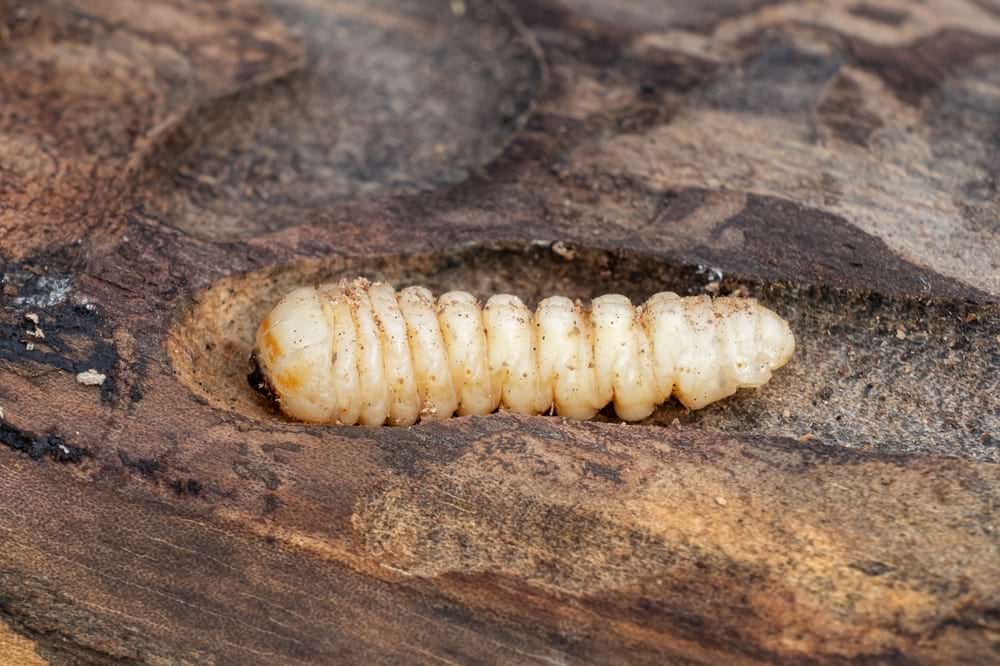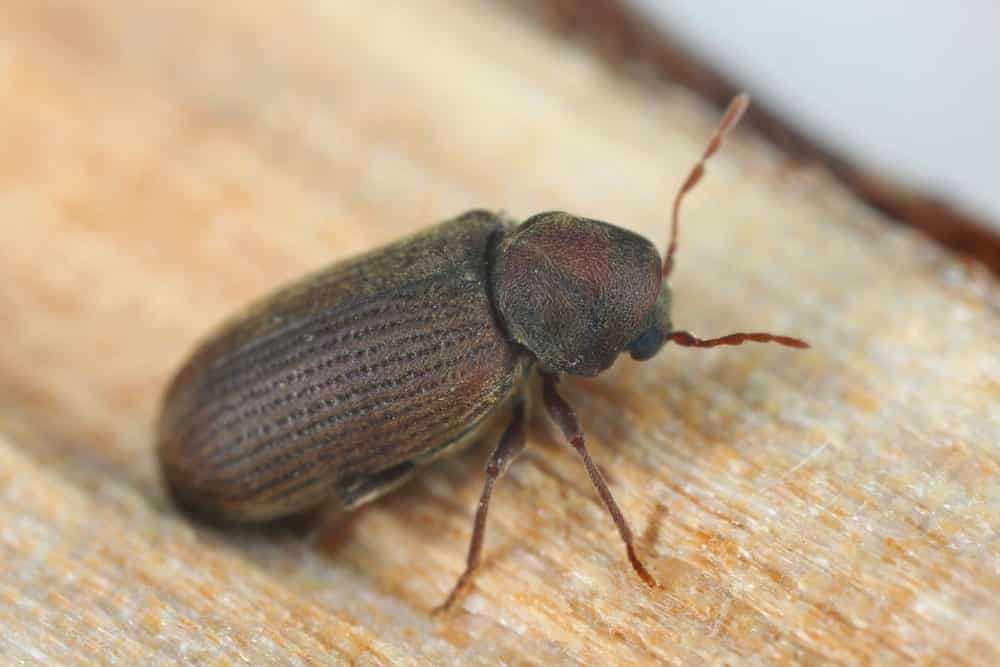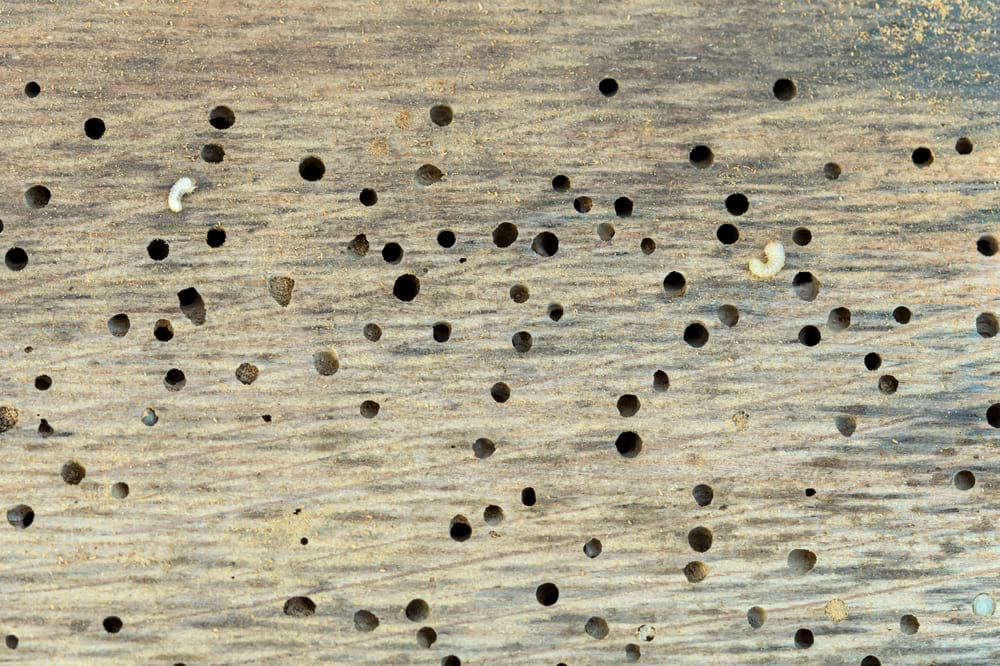There are several house pests in the UK.
One of the best examples of this is woodworm.
So, what is woodworm? And what are signs that you’ve got it?
We’ve answered these questions in this blog.
What is woodworm?

Woodworm is the name for the larvae of beetles that bore into furniture.
Once these larvae hatch, they feed on wood, creating passages and tunnels within it. This weakens the structure and affects its appearance over time.
There are several types of woodworm found in the UK, including:
- Common Furniture Beetle
- Death Watch Beetles
- Powderpost Beetles.

It’s rare for a woodworm to be larger than 6 millimetres in length. This makes them extremely small and difficult to spot.
Usually, they are white or cream, and their body takes the form of a ‘C’. You’ll tend to see lines going along their body.
How common is woodworm?
Woodworm is common in the United Kingdom, especially with older properties.
You’re likely to find them in major wooden structures, including timber frames and floorboards.
It’s slightly less common to find woodworm in furniture.
This is because they thrive in conditions with a higher moisture content than most household items.
Sections closer to the outside of the building are thus more vulnerable.
You’re most likely to find woodworms in the spring and summer.
Is woodworm dangerous or harmful?
Woodworms do not pose a direct threat to humans. They are not known to bite people or spread diseases.
But woodworms are harmful to your property.
They will burrow into timber and thus slowly destroy its strength. This can cause significant structural damage to your property if left unaddressed.
Furthermore, parasites will sometimes breed inside woodworm. These can be harmful to people.
Therefore, you should eliminate woodworms from your house as soon as possible.
How does woodworm get into the house?
Woodworm can get into your house through two methods.
Firstly, woodworm can arrive via adult beetles laying eggs.
This creates the larvae known as woodworm, which can burrow into the wooden surfaces they’re born on.
You can also introduce woodworm into your property by bringing in wood that is already infested with it.
This is especially common when you buy timber or furniture from a car boot sale, or an online marketplace.
In some cases, the woodworm might’ve already been in your house when you bought it.
Your seller will ideally have informed you of this, and your survey should have picked it up.
Signs that you’ve got woodworm in your house
Sightings
If you’ve got a woodworm infestation, then you may be able to spot it by simply looking close enough.
You’ll see white, C-shaped insects in the wood. If you see this, it’s time to take action to rectify the situation (more on this further below).
Small holes in wood
Even if you don’t spot the woodworm themselves, you’ll see lots of small holes in the wood.
Over several months, these can be easy to spot, since there’s so many of them. This is the entrance point where woodworm has burrowed in.
Weak and crumbling wood
Woodworm causes timber to weaken and crumble. This is a result of the larvae burrowing into the surface.
So, if you spot weak and crumbling wood and can’t explain how it’s happened, this could be a sign.
Presence of beetles
Woodworm comes from beetles laying their eggs.
So, seeing beetles in your home could be an early warning that woodworm is on the way, or already in the timber around your house.
Ways to reduce likelihood of woodworm
Avoid bringing in infested wood
You should be wary about bringing timber into your house.
If you buy furniture from someone, or new floorboards, then make sure to inspect it carefully.
Alternatively, avoid the purchase of wood from external sources.
Or only go to verified sellers who guarantee in writing that no woodworms are present.
Reduce moisture levels
Higher moisture levels enable woodworm to thrive. Keeping moisture levels down can thus make woodworm far less likely to survive.
Ensure proper ventilation in all your rooms and maybe install a dehumidifier.
Add a protective layer to wood
You can protect the timber inside your house, to stop woodworm from getting in.
Applying a protective sealant is one example. Paint or varnish being popular choices.
You may also be able to place an external layer around the wood, which prevents beetles from entering it.
Use natural deterrents for woodworm
There are natural elements that deter woodworm. The best examples include:
- Cedarwood
- Lavender oil
- Tea tree oil.
Borax solutions also work. Place these inside your house, especially close to the timber.
What todo if there’s woodworm in your house
Double-check your diagnosis
You mustn’t be mistaken about what the problem is. Otherwise, your remedying action could be incorrect, and the situation may persist.
Sightings of the woodworm can confirm that you’re right.
Also, you may want to bring in an expert, who can say whether woodworm is what you’re dealing with.
Consider DIY treatments
Not everyone immediately hires a pest control expert. There are DIY solutions you may wish to consider.
Insecticidal sprays can be highly effective. Just make sure to do thorough research, so you use the right one.
Heat treatment has also been known to work. You can also apply a 1:1 mixture of white vinegar and water to deter woodworms.
Bring in a professional
Many people feel more comfortable by having a professional by their side. If this applies to you, then you’re not alone!
It’s usually safer to take this approach. Just make sure you’ve got the budget to afford it.
A pest control expert will typically make more than one visit. They can outline how long it’ll take to eradicate the issue.
Commit to ongoing prevention
By removing all the woodworm from your house, there’s only one thing left to do: commit to ongoing prevention.
Reduce the moisture levels in your house through sufficient ventilation.
Natural deterrents can help, too, such as:
- Cedarwood
- Lavender oil
- Tea tree oil.
As can placing coverings on your timber helps as well.
Does woodworm impact property value?
Yes, woodworm reduces the value of your property.
You must always be honest about any infestations to buyers when selling your house. Otherwise, you could be sued for damages.
If the infestation is localised in a small place, it’ll often reduce value by up to 5%.
However, in the worst-case scenario, which affects the entire house, around 10% is more likely.



















